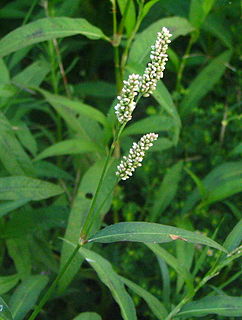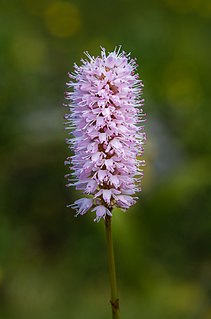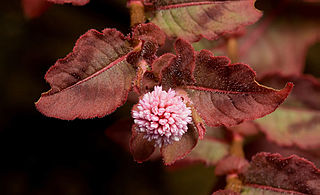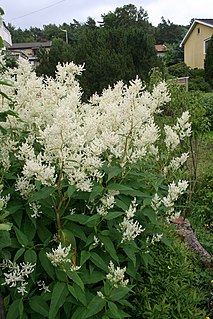
The Polygonaceae are a family of flowering plants known informally as the knotweed family or smartweed—buckwheat family in the United States. The name is based on the genus Polygonum, and was first used by Antoine Laurent de Jussieu in 1789 in his book, Genera Plantarum. The name may refer to the many swollen nodes the stems of some species have, being derived from Greek, poly meaning 'many' and gony meaning 'knee' or 'joint'. Alternatively, it may have a different derivation, meaning 'many seeds'.

Bistorta officinalis, known as bistort, common bistort, European bistort or meadow bistort, is a species of flowering plant in the dock family Polygonaceae native to Europe and northern and western Asia. Other common names include snakeroot, snake-root, snakeweed and Easter-ledges.

Erica arborea, the tree heath or tree heather, is a species of flowering plant (angiosperms) in the heather family Ericaceae, native to the Mediterranean Basin and Ethiopia, Kenya and Tanzania in East Africa. It is also cultivated as an ornamental.

Persicaria is a genus of herbaceous flowering plants in the knotweed family, Polygonaceae. Plants of the genus are known commonly as knotweeds or smartweeds. It has a cosmopolitan distribution, with species occurring nearly worldwide. The genus was segregated from Polygonum.

Polygonum is a genus of about 130 species of flowering plant in the buckwheat and knotweed family Polygonaceae. Common names include knotweed and knotgrass. In the Middle English glossary of herbs Alphita, it was known as ars-smerte. There have been various opinions about how broadly the genus should be defined. For example, buckwheat has sometimes been included in the genus as Polygonum fagopyrum. Former genera such as Polygonella have been subsumed into Polygonum; other genera have been split off.

Androsace, commonly known as rock jasmine, is a genus of flowering plants in the family Primulaceae, second only to Primula in the number of species. It is predominantly Arctic–alpine, with many species in the Himalayas, the mountains of central Asia, the Caucasus, and the southern and central European mountain systems, particularly the Alps and the Pyrenees.

Bistorta affinis, the Himalayan bistort, fleece flower, or knotweed, is a species of flowering plant in the family Polygonaceae, native to the Himalayas.

Darmera peltata, the Indian rhubarb or umbrella plant, is a flowering plant, the only species within the genus Darmera in the family Saxifragaceae. It is a slowly spreading rhizomatous perennial native to mountain streamsides in woodland in the western United States, growing to 2 m tall by 1 m wide. The name Darmera honours Karl Darmer, a 19th-century German horticulturist.

Koenigia is a genus of plants in the family Polygonaceae. The genus Aconogonon has been merged into Koenigia.

Clematis alpina, the Alpine clematis, is a flowering deciduous vine of the genus Clematis. Like many members of that genus, it is prized by gardeners for its showy flowers. It bears 1 to 3-inch spring flowers on long stalks in a wide variety of colors. C. alpina is native to Europe; in the United States it grows best in American Horticultural Society zones 9 to 6, which are generally found in the southern USA.

Bistorta is a genus of flowering plants in the family Polygonaceae. As of February 2019 about 40 species are accepted. It has been supported as a separate clade by molecular phylogenetic analysis. Bistorta species are native throughout much of the Northern Hemisphere, as far south as Mexico in North America and Thailand in Asia.

Koenigia weyrichii, the Chinese knotweed or Weyrich's knotweed, is a large, perennial, rhizomatous herb native to East Asia.

Arabis caucasica is a species of flowering plant in the mustard family (Brassicaceae) known by the common names garden arabis, mountain rock cress or Caucasian rockcress.

Koenigia alpina, commonly known as alpine knotweed, is similar to Koenigia alaskana, but differs in leaf size and achene characteristics. It is native to Europe and temperate Asia.

Koenigia polystachya is a species of flowering plant in the knotweed family, known by the common names Himalayan knotweed and cultivated knotweed. It has several regularly used synonyms, including Polygonum polystachyum, Aconogonon polystachyum and Persicaria wallichii.
Fleeceflower is a common name for genera and species in the subfamily Polygonoideae, and may refer to:
Campanula alaskana is a species of flowering plant in the family Campanulaceae, native to north-western North America. It was first described by Asa Gray in 1886 as Campanula rotundifolia var. alaskana and elevated to a full species by William Wright in 1918.

Tanja Magdalena Schuster is a taxonomist from Kaindorf, Austria and the first Pauline Ladiges Plant Systematics Fellow, holding a joint position with the School of Biosciences, University of Melbourne, Victoria, Australia, and the National Herbarium of Victoria, Royal Botanic Gardens Melbourne. Schuster also worked as curator of the Norton-Brown Herbarium at the University of Maryland, College Park.

Koenigia × fennica, known as Finnish knotweed, is a hybrid between two species of Koenigia, K. alpina and K. weyrichii, members of the family Polygonaceae, the knotweed family. It generally only known as a cultivated garden plant, but plants have been recorded a few times surviving in abandoned areas in northern Europe, especially in Finland. The cultivar 'Johanniswolke' is considered an attractive ornamental perennial plant.

Bistorta vacciniifolia, the whortleberry-leaved knotweed, is a species of flowering plant in the family Polygonaceae, native to Tibet and the Himalaya. Well-suited for clay soils, as its synonym Persicaria vacciniifolia it has gained the Royal Horticultural Society's Award of Garden Merit.


















